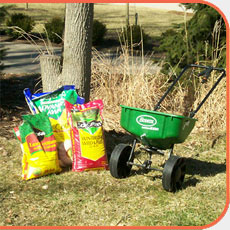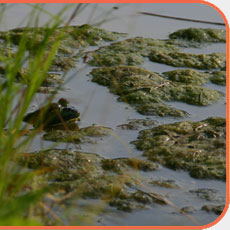Protect our water resources…through fertilizing wisely.
 Developing a lawn care strategy can reduce the effort, time, and expense of maintaining a luxurious green lawn. A green, healthy lawn requires soil that provides good growing conditions. You can determine the composition of your soil by using a soil test kit. Soil test kits can be purchased at your local hardware or home improvement store. The important soil composition to test for and the important ingredients in lawn fertilizer are nitrogen, phosphorus, and potassium (often abbreviated N-P-K). These make up the bulk of most fertilizer applications. The desired application amounts change depending on the season and soil composition. Labels provide the percentage of nutrients in fertilizer. For instance, a bag labeled 10-5-5 indicates there is 10% nitrogen, 5% phosphorus and 5% potassium in the fertilizer. The best fertilizer ratio to use on your lawn is around 5-1-2. You can use fertilizers with different numbers as long as they are close to the same ratio. For example, 10-2-4 is equivalent to 5-1-2; it just contains twice as much of each nutrient. You need to be sure to use less if you use higher numbers.
Developing a lawn care strategy can reduce the effort, time, and expense of maintaining a luxurious green lawn. A green, healthy lawn requires soil that provides good growing conditions. You can determine the composition of your soil by using a soil test kit. Soil test kits can be purchased at your local hardware or home improvement store. The important soil composition to test for and the important ingredients in lawn fertilizer are nitrogen, phosphorus, and potassium (often abbreviated N-P-K). These make up the bulk of most fertilizer applications. The desired application amounts change depending on the season and soil composition. Labels provide the percentage of nutrients in fertilizer. For instance, a bag labeled 10-5-5 indicates there is 10% nitrogen, 5% phosphorus and 5% potassium in the fertilizer. The best fertilizer ratio to use on your lawn is around 5-1-2. You can use fertilizers with different numbers as long as they are close to the same ratio. For example, 10-2-4 is equivalent to 5-1-2; it just contains twice as much of each nutrient. You need to be sure to use less if you use higher numbers.
 Most southwestern Ohio lawns already contain high levels of phosphorus due to previous agricultural practices. Adding more phosphorus will not help your lawn but will cause algae growth in your retention pond. It is recommended that you purchase fertilizer that contains little or no phosphorus.
Most southwestern Ohio lawns already contain high levels of phosphorus due to previous agricultural practices. Adding more phosphorus will not help your lawn but will cause algae growth in your retention pond. It is recommended that you purchase fertilizer that contains little or no phosphorus.
The chart below indicates appropriate seasonal amounts for southern Ohio lawns.
| Pounds of fertilizer to use per 1000 sq. ft.: | ||||
| Fertilizer Type | Apr-May | Jun-Jul | Aug-Sep | Oct-Nov |
| 15-5-10 | 3 | 3 to 7 | 7 | 7 to 13 |
| 19-5-10, 20-4-8 | 3 | 3 to 5 | 5 | 5 to 10 |
| 24-4-8, 24-4-12 | 2 | 2 to 4 | 4 | 4 to 8 |
| 34-5-10 | 2 | 2 to 3 | 3 | 3 to 6 |
Adapted from The Ohio State University fertilizer fact sheet.
Here are some guidelines for how much fertilizer to use and when:
- Over fertilizing can make maintaining a retention pond more difficult than necessary.
- Excessive use of lawn fertilizer applications can result in overflow of nutrients into the pond. Algae thrive on the same chemicals in fertilizer that help your grass to grow. Often this can cause algal blooms to increase and make the pond more susceptible to harmful bacteria, such as E. coli.
- It is important to apply fertilizers when the time is right. Grass has an ideal temperature at which the roots will begin to absorb the fertilizers. Southern Ohio lawns should have fertilizers applied only when soil temperatures are at or above 54 degrees. It is also important to apply any lawn application at least 24 hours before or directly after a rain event. This will ensure that the lawn application will be absorbed by the soil and won’t run off into your retention pond.
- The roots of any plant can absorb a limited amount of fertilizer. Adding excess fertilizer will only contaminate nearby surface water, including retention ponds. This is a double waste of money– you waste the fertilizer and have to pay to treat the pond!
An easy way to save on fertilizer costs is using a mulching mower that leaves grass clippings on your lawn. This reduces the amount of fertilizer your lawn needs by 25%.
